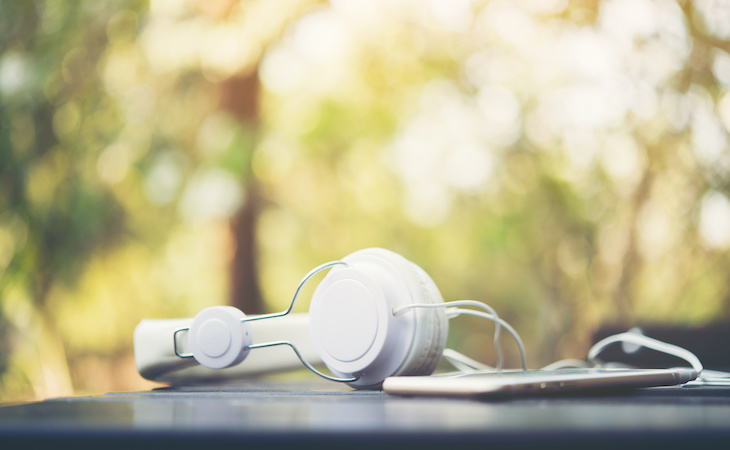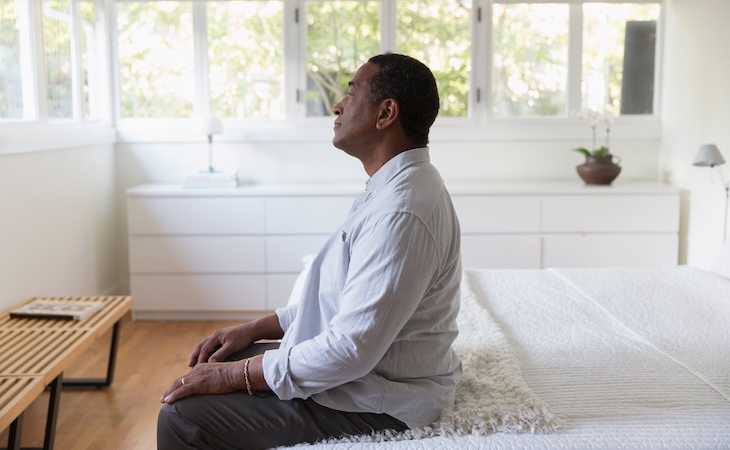White noise, which is a noise that stays consistent across all hearable frequencies, has long been a go-to for people who need a little background noise to help them fall (and stay) asleep. [1]
But in recent years, other types of static noise have been gaining traction as effective sleep aids, like brown noise (which is focused on extremely low frequencies) or pink noise (which mixes high and low frequencies).
And for good reason! Whatever the color, “consistent static noise on a similar frequency can help many people sleep more soundly,” says Chelsie Rohrscheib, PhD, neuroscientist and head sleep expert at Wesper. [2]
That includes the newest color noise on the block, one that could be even more effective than the rest of the spectrum—and that’s green noise.
Many followers are claiming that green noise is the key to increased calm and better sleep. But what does green noise do? What is green noise good for? And, most importantly, is green noise good for sleep?
What is green noise?
Green noise is a mid-to-low-frequency form of noise (generally around 500 Hz, according to the Huffington Post) that mimics the sounds of nature—for example, rolling waves, rushing waterfalls, or gusts of wind. And playing those sounds as you fall asleep—and throughout the night—can help improve the overall quality of your sleep. [3]
How?
“In order to fall asleep, our brain has to reduce its heightened awareness of stimuli in our sleeping environment,” explains Rohrscheib. “Some people have a heightened awareness, usually related to stress, that makes it super difficult to fall asleep. This is especially true when there is inconsistent, random noise—such as street noise or the sound of your pet moving—that keeps the brain on high alert.” [2]
Rohrscheib says using a consistent background noise—such as green noise, which doesn’t change frequency—can mask the inconsistent noises in your bedroom that are keeping you awake. “[Green noise] also helps the brain relax and brings your nervous system into a state of relaxation,” she adds.
Basically, green noise can help you tune out any loud or distracting sounds while also helping you unwind and relax—both of which set you up for getting a great night’s sleep.
The benefits of green noise
Next up: What is green noise good for?
As mentioned, green noise offers a number of benefits—mainly in helping to create a more sleep-friendly environment, both internally and externally.
“Green noise…helps us block out sounds in our environment that would keep us awake,” says Rohrscheib. “Green noise also helps the brain and body to relax, making us more primed for sleep.”
There’s research to support that a variety of noise types—like white noise, pink noise, or even certain types of music—can help improve sleep quality. But green noise can be especially effective in promoting better sleep. [2, 4, 5]
For example, one study found that listening to nature sounds (aka green noise) helped to improve overall sleep quality for patients in hospital settings—where environmental noise and other distractions, like harsh lighting, commonly disrupt sleep. [3]
Plus, the nature-inspired sounds of green noise can, for some, be easier to adjust to than other types of noise. “Green noise is more natural than white noise, so adjusting to using green noise while you sleep is easier for many people,” says Rohrscheib.
“Green noise…helps us block out sounds in our environment that would keep us awake. Green noise also helps the brain and body to relax, making us more primed for sleep.”
Chelsie Rohrscheib, PhD
Green noise vs. white noise: What’s the difference?
There are a few differences between white noise and green noise—starting with frequency. White noise is a type of noise that remains consistent across all frequencies—while green noise has a low frequency (again, typically around 500 Hz).
There are also differences in the way white noise and green noise actually sound. “White noise…tends to sound more mechanical like static or a fan—whereas green noise sounds more like nature, similar to sounds of rain, waves, or wind,” says Rohrscheib.
Green noise is generally a mix of different nature-inspired sounds, which can make for a soothing listening experience—and can also include other types of targeted noise for sleep, like brown noise (which uses deep, bass tones, like thunder) or pink noise (which is centered on creating a consistent experience, like the steady fall of rain). [6, 7]
How to use green noise for better sleep
Does drifting off to the sounds of nature sound like your idea of a great night’s sleep? Here are a few tips to get the green noise sleep you’re dreaming of:
Choose the right length and volume
In order to get green noise’s maximum sleep-boosting benefit, it’s important to start listening before you fall asleep—and keep listening until it’s time to wake up.
“Ensure that your green noise plays long enough for the entire duration of your sleep,” says Rohrscheib. “If your green noise cuts off too early, this may trigger your brain to wake up.”
It’s also important to make sure your green noise is at the ideal volume. “Make sure your green noise is loud enough to block external sounds in your environment but not loud enough to be stimulating or distracting,” says Rohrscheib.
Find the right green noise
To use green noise to get better sleep, you have to know where to find it. Green noise YouTube videos are a great way to leverage green noise to improve your sleep. The platform is full of videos (many of which are 12+ hours long!) that you can put on before bed and listen to as you drift off to sleep.
Need some videos to get started? Here are some green noise YouTube videos to try tonight:
FAQs
What is green noise good for?
Green noise is good for blocking out loud, distracting noises that might prevent you from getting a good night’s rest. It can also help you achieve a more relaxed state, which can make it easier to fall and stay asleep.
How do you listen to green noise?
You can listen to green noise in whatever way feels the most comfortable for you—for example, through headphones, your phone or computer speaker, or a Bluetooth speaker next to your bed.
What color noise is best for sleep?
There’s no one-size-fits-all answer to what color noise is best for sleep; while some people prefer green noise, others prefer white, brown, or pink. If you want to use noise to get better sleep, experiment with different types of noise to find the one that works best for you.
Having trouble falling asleep? We’ve compiled the best ways to fall asleep fast when drifting off just isn’t happening.
References
- Messineo, L., Taranto-Montemurro, L., Sands, S. A., Oliveira Marques, M. D., Azabarzin, A., & Wellman, D. A. (2017). Broadband Sound Administration Improves Sleep Onset Latency in Healthy Subjects in a Model of Transient Insomnia. Frontiers in neurology, 8, 718. https://doi.org/10.3389/fneur.2017.00718
- Ebben, M. R., Yan, P., & Krieger, A. C. (2021). The effects of white noise on sleep and duration in individuals living in a high noise environment in New York City. Sleep medicine, 83, 256–259. https://doi.org/10.1016/j.sleep.2021.03.031
- Nasari, M., Ghezeljeh, T.N., Haghani, H. (2018). Effects of Nature Sounds on Sleep Quality among Patients Hospitalized in Coronary Care Units: A Randomized Controlled Clinical Trial. Nursing and Midwifery Studies, 7(1):p 18-23. DOI:10.4103/nms.nms_39_17
- Lu, S. Y., Huang, Y. H., & Lin, K. Y. (2020). Spectral content (colour) of noise exposure affects work efficiency. Noise & health, 22(104), 19–27. https://doi.org/10.4103/nah.NAH_61_18
- Harmat, L., Takács, J., & Bódizs, R. (2008). Music improves sleep quality in students. Journal of advanced nursing, 62(3), 327–335. https://doi.org/10.1111/j.1365-2648.2008.04602.x
- University of Washington. What Is Pink Noise? https://rightasrain.uwmedicine.org/body/rest/pink-noise
- Sleep Foundation. What Is Green Noise and How Can It Help You Sleep? https://www.sleepfoundation.org/noise-and-sleep/what-is-green-noise




